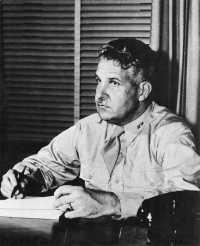Maj. Gen. Leslie R. Groves, Officer in Charge, Manhattan Project
Foreword
The U.S. Army played a key role in the formation and administration of the Manhattan Project, the World War 11 organization which produced the atomic bombs that not only contributed decisively to ending the war with Japan but also opened the way to a new atomic age. This volume describes how the wartime Army, already faced with the enormous responsibility of mobilizing, training, and deploying vast forces to fight a formidable enemy on far-flung fronts in Europe and the Pacific, responded to the additional task of organizing and administering what was to become the single largest technological project of its kind undertaken up to that time.
To meet this challenge, the Army – drawing first upon the long-time experience and considerable resources of its Corps of Engineers – formed a new engineer organization, the Manhattan District, to take over from the Office of Scientific Research and Development administration of a program earlier established by American and refugee scientists to exploit the military potentialities of atomic energy. Eventually, however, the rapidly expanding project turned for support and services to a much broader spectrum of the Army, including the War Department, the Ordnance Department, the Signal, Medical, Military Police, and Women’s Army Corps, the Military Intelligence Division of the War Department General Staff, and the Army Air Forces. These and other Army elements worked together in close collaboration with American industry and science to win what was believed to be a desperate race with Nazi Germany to be first in producing atomic weapons. For both soldiers and civilians this history of the Army’s earlier experience in dealing successfully with the then novel problems of atomic science seems likely to offer some instructive parallels for finding appropriate answers to the problems faced in today’s ever more technologically complex world.
Douglas Kinnard
Brigadier General, USA (Ret.)
Chief of Military History
Washington, D.C.
1 March 1984
The Author
Vincent C. Jones, after graduating from Park College (Parkville, Missouri) with a B.A. in history, earned an M.A. degree at the University of Nebraska with a thesis on German public opinion in World War I and spent a year as a Sanders Fellow in History at George Washington University. Moving to the University of Wisconsin, he began work on a doctoral degree in modern European history just before the outbreak of World War II in Europe. During the war, he was a noncommissioned officer in a heavy weapons company of the 81st Infantry Division, participating in the Peleliu-Angaur and Leyte campaigns in the Pacific Theater. He was in training in the Philippines in August 1945, preparing for the impending invasion of Kyushu, when the Army Air Forces dropped atomic bombs on Hiroshima and Nagasaki. Following the surrender of Japan, he served in the American occupation forces in that country before returning to the University of Wisconsin as an instructor in history.
Completing his doctorate at Wisconsin in 1952, Dr. Jones served a year as a research associate in American history at the State Historical Society of Wisconsin and as an assistant professor of history at the Central State College of Connecticut. Since January 1955 he has been a historian on the staff of the U.S. Army Center of Military History, where he has been a major contributor to The Army Almanac and the ROTC textbook American Military History. In addition to the present volume, Dr. Jones is author of articles and reviews in professional journals and of biographical sketches of military figures in a number of encyclopedias.
